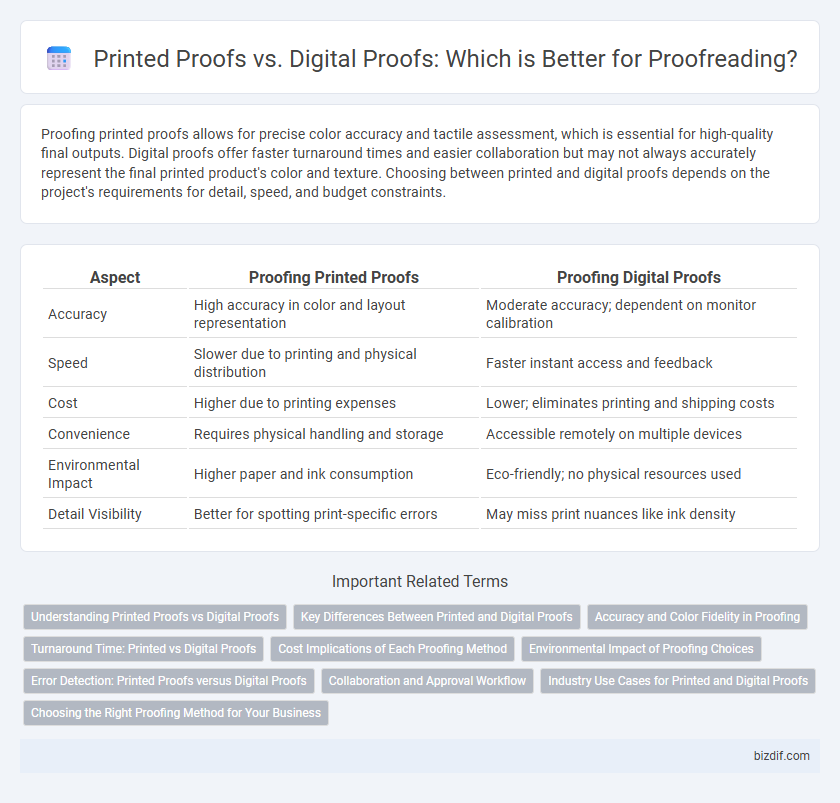Proofing printed proofs allows for precise color accuracy and tactile assessment, which is essential for high-quality final outputs. Digital proofs offer faster turnaround times and easier collaboration but may not always accurately represent the final printed product's color and texture. Choosing between printed and digital proofs depends on the project's requirements for detail, speed, and budget constraints.
Table of Comparison
| Aspect | Proofing Printed Proofs | Proofing Digital Proofs |
|---|---|---|
| Accuracy | High accuracy in color and layout representation | Moderate accuracy; dependent on monitor calibration |
| Speed | Slower due to printing and physical distribution | Faster instant access and feedback |
| Cost | Higher due to printing expenses | Lower; eliminates printing and shipping costs |
| Convenience | Requires physical handling and storage | Accessible remotely on multiple devices |
| Environmental Impact | Higher paper and ink consumption | Eco-friendly; no physical resources used |
| Detail Visibility | Better for spotting print-specific errors | May miss print nuances like ink density |
Understanding Printed Proofs vs Digital Proofs
Printed proofs offer a tangible, high-fidelity representation of the final product, enabling proofreaders to detect color accuracy, paper texture, and layout inconsistencies that digital screens may not reveal. Digital proofs provide convenience and speed, allowing quick edits and annotations during the review process, yet they may lack the precise color calibration and detail clarity found in printed versions. Understanding the differences between printed and digital proofs is essential for selecting the appropriate proofing method to ensure accurate quality control in publishing and printing workflows.
Key Differences Between Printed and Digital Proofs
Printed proofs offer accurate color representation and true-to-material texture verification, essential for final product approval in industries like packaging and publishing. Digital proofs enable rapid revisions and collaborative feedback through screen-based viewing but may lack precise color fidelity due to monitor calibration variations. Understanding these key differences ensures optimal proofing strategies tailored to accuracy or speed requirements.
Accuracy and Color Fidelity in Proofing
Proofing printed proofs ensures superior color fidelity due to the tangible representation of ink and paper interactions, offering accurate color matching critical in final production stages. Digital proofs provide quick and cost-effective previews but may lack the precise color accuracy of physical proofs due to screen calibration variances and backlighting effects. Prioritizing printed proofs in critical print jobs improves accuracy in color reproduction, minimizing costly errors and maintaining brand consistency.
Turnaround Time: Printed vs Digital Proofs
Turnaround time for digital proofs is significantly faster, often allowing for same-day reviews and edits due to instant online access and real-time collaboration. Printed proofs require additional time for printing, shipping, and handling, which can delay feedback cycles by several days. Choosing digital proofs enhances efficiency, especially in fast-paced production environments where rapid turnaround is essential.
Cost Implications of Each Proofing Method
Proofing printed proofs involves higher material and labor costs due to paper, ink, and manual inspection, which can increase overall production expenses. Digital proofs reduce these costs significantly by eliminating physical materials and enabling faster revisions through software, lowering the total proofing budget. However, digital proofing may require investment in reliable hardware and color calibration tools to ensure accuracy, balancing initial expenses against long-term savings.
Environmental Impact of Proofing Choices
Printing physical proofs consumes significant amounts of paper, ink, and energy, contributing to deforestation and carbon emissions. Digital proofs dramatically reduce waste by eliminating the need for physical materials and allowing instant revisions without additional resources. Choosing digital proofing supports sustainable practices and minimizes the environmental footprint associated with traditional print production.
Error Detection: Printed Proofs versus Digital Proofs
Proofing printed proofs enhances error detection through tactile inspection and color accuracy, which digital proofs may struggle to replicate due to screen calibration differences and resolution limitations. Printed proofs allow for easier identification of layout inconsistencies, smudges, and imperfections that might be overlooked on digital displays. Digital proofs facilitate quick revisions and collaborative review but can miss subtle print-specific errors critical in final production quality.
Collaboration and Approval Workflow
Proofing printed proofs allows tactile examination and precise color accuracy, facilitating detailed collaboration among stakeholders who review physical copies together. Digital proofs enhance approval workflows by enabling real-time comments, version tracking, and faster distribution across remote teams, streamlining decision-making processes. Combining both methods optimizes collaboration efficiency and ensures thorough quality control before final production.
Industry Use Cases for Printed and Digital Proofs
Printed proofs remain critical in packaging and publishing industries where color accuracy and tactile quality are paramount, enabling detailed inspections before mass production. Digital proofs dominate advertising and web content sectors by offering rapid revisions and cost-effective workflow integration, supporting faster project turnaround times. Both methods complement workflows in fashion and product design, where precise color matching and layout validation ensure brand consistency across physical and digital media.
Choosing the Right Proofing Method for Your Business
Selecting the right proofing method for your business depends on accuracy, turnaround time, and cost-efficiency. Printed proofs offer tangible color accuracy and detail verification, essential for high-quality print projects, while digital proofs provide faster revisions and easier collaboration in remote settings. Balancing these advantages ensures optimal workflow and final product quality tailored to your specific production needs.
Proofing Printed Proofs vs Digital Proofs Infographic

 bizdif.com
bizdif.com